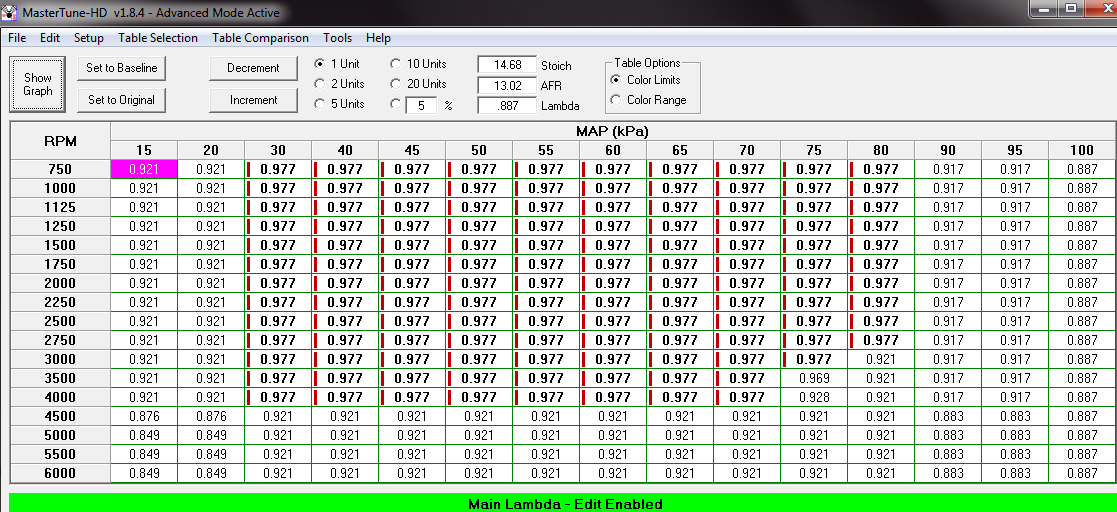
BEFORE: Front cylinder AFR samples taken at 10,15,20,30,40,60,80,100% throttle. Target AFR=13:1

AFTER: Delphi EFI (speed density) after VE table corrections. Target=13:1
In addition to the ignition timing, the other aspect of vehicle tuning that is most commonly addressed is the fuel delivery. The amount of fuel being sent into the combustion chambers is commonly measured as an “air/fuel ratio” which is just like it sounds – a number representing the ratio of the amount of air to the amount of fuel being burned in the engine.
An internal combustion engine mixes fuel with oxygen in the air and then ignites that mixture with a spark plug. From a strictly scientific point of view, the optimum mixture of air and common gasoline is around 14.6 parts of air to every one part of fuel for an air/fuel ratio of 14.6:1. At this ratio and under the right conditions, all of the gasoline and all of the oxygen can burn leaving nothing except for the combustion products.
This is called the “stochiometric” ratio.
It is just like the ratio of 2:1 for hydrogen and oxygen, as when they react (or burn) in that ratio and under the right conditions, everything is used up and only water (or H2O) is left. Fortunately for us, the oxygen in the air is never completely used up when gasoline is burned. The main reason for this is the fact that air is only 20% oxygen, and the remaining 80% is comprised of things that will interfere with a perfect reaction. If one were to mix gasoline with pure oxygen, the stochiometric ratio would be approximately 3:1 and the reaction would be entirely more dramatic with a much greater chance of a “complete burn.”
Higher ratios
or mixtures that contain more air than what is desired are considered “lean.” Lower ratios, or mixtures that contain more gasoline that what is desired are considered “rich.” The two terms are used much like “retarded” and “advanced” when describing ignition timing. Historically, the terms were used to describe deviations from stochiometric, much like “retarded” and “advanced” were used to describe deviations from TDC, but they can also be used to describe deviations from the desired point and changes to the current state. “Leaning” the mixture means adding air (or reducing fuel) and “enriching” the mixture means adding fuel (or reducing air.)
Since there is always some oxygen left in the exhaust gas stream of a running engine, we have an easy way of measuring the air/fuel ratio. An “oxygen sensor” can be used to measure the percentage of oxygen left in the gas stream, and a computer or other electronic device can be used to back-calculate the air/fuel ratio that will result in that particular oxygen percentage. “Narrow-band” oxygen sensors respond with a voltage output that is sent to the computer that is between 0 and 1 volt. “Wide-band” oxygen sensors send a 0 to 5 volt signal which allows for a much higher resolution and are therefore much better for tuning. “Lambda” is a commonly used term that is used in place of the air/fuel ratio number, as many devices use or report lambda values.
A lambda of 1.0 is equal to the stochiometric ratio (14.6:1 for air/gasoline)
and is adjusted accordingly – a lambda of 0.880 is equal to 13:1 air/fuel ratio.
The “best” air/fuel ratio
for a particular vehicle is a matter of great debate and I will do my best to avoid that debate in this article. Simply put, there are a number of factors that one must consider in determining the best ratio, including power, safety, and fuel economy. Fuel economy is the easiest to understand, as a lower air/fuel ratio means more fuel and obviously lower fuel economy. As far as safety is concerned, richer is considered safer (to a point) as the extra fuel helps things run cooler. The lower temperatures help reduce the chance of autoignition and can literally keep engine components from melting.
The safest air/fuel ratios are continuously being debated, but it is widely accepted that 13:1 is a good ratio for normally aspirated engines and 12:1 is good for forced induction engines. Many choose to go even richer, even 11.5:1.

Autoignition
(or “detonation” or “knocking”) is considered a critical concern with rotary engines, and many tuners choose to go even richer than that. One must also keep in mind that these “safe” ratios are considered safe because they have been tried with many thousands of vehicles over many years by dyno operators that use the same equipment that most people are likely to encounter. Therefore, a safety margin that takes into account the accuracy of that equipment is inherently factored in. If it were common for turbocharged cars to blow up at 12:1 as measured on commonly used equipment, then the “safe” air/fuel ratio would have been lowered.
As far as power is concerned, I’ll say only this: Every vehicle is different. If one wants to find the best air/fuel ratio for generating power, one should put the vehicle on a dyno and test it. Many believe that a particular ratio will result in the most power under any circumstances, and that belief is just too narrow-minded. There are far too many factors involved to make such blanket statements.
Regardless of the actual ideal air/fuel ratio number, almost everyone wishes to see a nice, flat air/fuel graph. This means that the ratio stays constant throughout the rpm range. A perfectly flat air/fuel graph is certainly not necessary for optimum engine performance or safety, but it is a nice thing to show off when tuning a vehicle. The smoother the air/fuel curve, the better the driveability will be and the smoother the power output will be. All good tuners realize that a little variation with the graph is perfectly acceptable, especially when one considers the factors involved.
One must consider the accuracy of the oxygen sensor,
where it is placed in the exhaust stream, the velocity of the exhaust stream at different points in the rpm band, the tools that the tuner has at his disposal to make changes, etc.
Another important factor is that most air/fuel ratios are measured via a tailpipe sniffer. This method has proven to be an excellent way of measuring the ratio, but it is not perfect at low rpm.
At low rpm, an engine may not be producing enough gas to displace all of the atmospheric air in the tailpipe
and this will produce a false lean reading because of the extra oxygen. This phenomenon is going to be more pronounced in small-bore engines with large diameter exhaust piping. Two important things must be considered when one is tuning with a tailpipe sniffer because of this phenomenon. One, a flat line across the entire rpm band will mean that the actual air/fuel ratio is too rich at low rpm. Two, a real-world driver is almost never at wide-open-throttle at such a low rpm, so the air/fuel curve at that point is something that the driver will never see.
The flatness of the air/fuel graph
when one is done tuning is mainly going to depend not on the competency of the tuner but on the type of fuel management system being used and its resolution, and the patience of the customer and/or his willingness to pay for dyno time. One must also ask – is a perfectly flat air/fuel curve best? Many assume that a flat line at 12:1 or 13:1 “across the board” is best, but why is that? How could it be possible that the exact same air/fuel ratio be optimum for every rpm and load? This idea has been largely ignored in automotive enthusiast circles, as “good” tuners with adequate engine management equipment produce air/fuel curves that are flat “across the board” at the desired ratio. Thankfully, this notion has been challenged recently, and
experienced racers and tuners have begun to realize that air/fuel curves should not necessarily be flat
Turbos can spool up faster if the ratio is a little lean during that time, and rich ratios are more needed in the higher rpm range where more heat is being produced. Keep in mind that wideband oxygen sensors have only been in widespread use since the late ’90′s, and chassis dyno testing has only become truly popular in recent years. All of us are still learning. Few people have been able to perform true scientific experiments, and therefore few people truly have the knowledge to make blanket statements concerning what is best for a particular vehicle or group of vehicles.
When performing dyno testing and tuning
one must ask oneself “what am I trying to achieve?” If maximum power is the goal, then just look at the power curve first and make adjustments accordingly. The fuel curve is only used as an aid. Many NA race car owners tune in this manner, and by the time they are done the air/fuel ratio is sometimes between 14:1 and 15:1. This is usually not considered “safe” by anyone, but most race car teams accept the fact that they usually change the engine at least once during a typical season. Most street car owners are willing to sacrifice the 3 – 5 hp that they might get by running so lean and instead opt for an air/fuel ratio that will help their engine last for many years.


